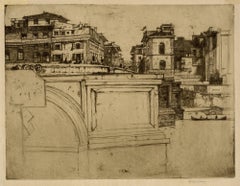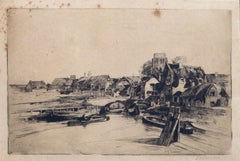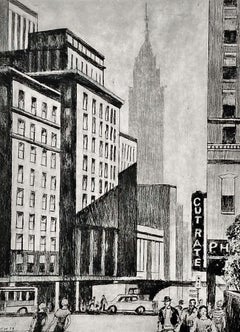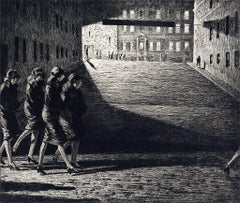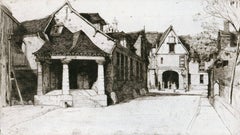David Young Cameron Landscape Prints
British, 1865-1945
Scottish painter, etcher, and draughtsman, born in Glasgow, the son of a clergyman. He abandoned brief unhappy careers in commerce and law to study at *Glasgow School of Art and the Royal Scottish Academy in Edinburgh. Most of his work consisted of landscapes (especially scenes of mountains) and architectural views, and he is best known for his etchings of buildings, including Gothic churches on the Continent, ”rich and sombre" works with which he established a reputation as one of the outstanding printmakers of the day.to
1
1
Overall Width
to
Overall Height
to
1
5
180
169
146
131
1
1
2
1
1
1
1
1
2
1
1
1
1
1
2
Artist: David Young Cameron
Ponte della Trinità, Florence
By David Young Cameron
Located in Middletown, NY
Etching and drypoint on tissue-thin cream laid paper, 6 5/8 x 8 1/8 inches (167 x 205 mm), full margins. Signed in pencil in the lower right margin, and inscribed "Ponte Trinità, Florence" in pencil the lower left margin. Non-archival paper tape tabs at the top right and left corners on the verso, with minor associated discoloration which presents on the recto. Minor, light mat tone, and some very small losses at the extreme corners, well outside of image area. The numerals "325" written in pencil in the lower right margin, in reference to the Rinder catalog number. A beautiful, silvery, early-state impression.
Rinder 325
[Rinder 325 iii/vii].
The son of a clergyman, Sir David Young Cameron was born in Glasgow in 1865. After a brief and unhappy dalliance in the fields of business and law, Cameron began attending the prestigious Glasgow School of the Arts in 1881, and later the Edinburgh School of the Arts. At first associated with the Glasgow Boys (John Lavery, Joseph Crawhall...
Category
Early 20th Century Modern David Young Cameron Landscape Prints
Materials
Laid Paper, Drypoint, Etching
DY Cameron 19th c. European Village Etching
By David Young Cameron
Located in New York, NY
D.Y. (David Young) Cameron (Scottish, 1865-1945)
The Border Tower, c. 1893
Etching
Sight: 9 x 13 1/4 in.
Framed: 15 1/4 x 19 1/2 x 1/2 in.
Signed in pencil lower right
Cameron trained at the Glasgow and Edinburgh Schools of Art in the early 1880s and was at first associated with the Glasgow Boys. He became a leader in the Scottish etching...
Category
1890s Academic David Young Cameron Landscape Prints
Materials
Etching
Related Items
The Spire -- New York
By Lawrence Wilbur
Located in Storrs, CT
The Spire -- New York. 1985. Etching and drypoint. 14 1/2 x 11 (sheet 22 1/2 x 18). Trial proof of the second third, prior to the edition of 100. Printed on Rives cream wove paper, on the full sheet with deckle edges. A rich impression in pristine condition, housed in an archival sleeve. This etching has never been matted. Provenance: the artist's estate. Titled, annotated 'third state - trial proof' and signed in pencil. A dramatic view of the Chrysler Building.
Painter and printmaker Lawrence Nelson...
Category
20th Century American Modern David Young Cameron Landscape Prints
Materials
Drypoint, Etching
Shadows on the Ramp
By Martin Lewis
Located in Storrs, CT
Shadows on the Ramp. 1927. Drypoint and sand ground. McCarron 64. 9 x 10 1/2 (sheet 12 3/8 x 14). Edition 75 recorded impressions. A rich, tonal impression with drypoint burr, printe...
Category
1920s American Modern David Young Cameron Landscape Prints
Materials
Drypoint, Etching
“On the Seine, Paris”
By Hans Figura
Located in Southampton, NY
Original aquatint etching of working river barges on the Seine in Paris, France. A horse drawn cart is seen loading or unloading product. Circa 1900. Si...
Category
Early 1900s Academic David Young Cameron Landscape Prints
Materials
Archival Paper, Aquatint
The Pool of London.
By William Lionel Wyllie
Located in Storrs, CT
The Pool of London. c. 1915. Etching and drypoint. 7 7/8 x 15 7/8 (sheet 11 x 14 7/8 x 21 1/4). A rich impression with drypoint burr printed on the full sheet of simili-Japan paper. ...
Category
1910s Modern David Young Cameron Landscape Prints
Materials
Drypoint, Etching
Botanical Triptych Cyanotype Print of Shady Majesty Palm Leaves Garden in Blue
By Kind of Cyan
Located in Barcelona, ES
This series of cyanotype triptychs showcases the beauty of nature scenes, including stunning beaches and oceans, as well as the intricate textures of water, forests, and skies. These...
Category
2010s Academic David Young Cameron Landscape Prints
Materials
Lithograph, Monotype, Paper
$704 Sale Price
20% Off
H 40 in W 83 in
Building a Babylon, Tudor City, NY.
By Martin Lewis
Located in Storrs, CT
McCarron 76. 12 7/8 x 7 7/8 (sheet 16 5/8 x 12 1/4). 6th trial proof (McCarron records 84 impressions including 4 trial proofs). Illustrated L'Amérique de la Dépression: Artistes En...
Category
Early 20th Century American Modern David Young Cameron Landscape Prints
Materials
Drypoint, Etching
$11,000 Sale Price
26% Off
H 24.5 in W 20 in D 1 in
“Paris, Place du Tertre”
Located in Southampton, NY
Original hand colored lithograph by the French artist, Maurice Jacque of the Place du Tertre in Montmartre Paris, France. Signed in lower right margin. Titled in lower left margin. ...
Category
Early 1900s Academic David Young Cameron Landscape Prints
Materials
Archival Paper, Lithograph
Stoops in Snow
By Martin Lewis
Located in Storrs, CT
Stoops in Snow. 1930. Drypoint and sandpaper ground. McCarron catalog 89.state ii. 9 x 14 7/8 (sheet 13 1/4 x 18 7/16 ). Edition 115 recorded impressio...
Category
1930s American Modern David Young Cameron Landscape Prints
Materials
Drypoint, Etching
“Flower Seller, Notre Dame”
Located in Southampton, NY
Very nice original hand colored copper plate etching (aquatint) by the Hungarian born artist, Marianne L. Almasy. Depicts a Parisian flower girl selling her bouquets with the iconic cathedral of Notre Dame. Handwritten bottom left in pencil, original etching 136/295. Handwritten in pencil by the artist lower right, L. Marianne. Condition: excellent. Provenance: Sarasota, Florida estate. Professionally matted with a one inch solid oak frame in a medium walnut stain. Overall 24 by 19 inches.
Marianne Almasy...
Category
1980s Academic David Young Cameron Landscape Prints
Materials
Archival Paper, Etching
London Bridge.
By William Lionel Wyllie
Located in Storrs, CT
London Bridge, London. 1924. Etching and drypoint. 6 3/8 x 14 3/4 (sheet 9 7/8 x 17 1/4). Mat line; otherwise fine condition. A rich impression with dryp...
Category
1920s Modern David Young Cameron Landscape Prints
Materials
Drypoint, Etching
Papaya and Moth Metamorphosis: 18th C. Hand-colored Engraving by Maria Merian
By Maria Sibylla Merian
Located in Alamo, CA
This exquisite hand-colored 18th century folio-sized engraving of a papaya plant and moth metamorphosis is plate 64 from Maria Sibylla Merian's publication '...
Category
Early 18th Century Academic David Young Cameron Landscape Prints
Materials
Engraving
$4,460 Sale Price
20% Off
H 21.88 in W 14.5 in
"Winter Wildfowling" Frank Weston Benson, Hunting Scene, Outdoors, Marshes
By Frank Weston Benson
Located in New York, NY
Frank Weston Benson
Winter Wildfowling, 1927
Signed lower left
Etching on paper
Image 8 1/2 x 7 inches
Born in Salem, Massachusetts, a descendant of a long line of sea captains, Benson first studied art at Boston’s Museum School where he became editor of the student magazine. In 1883, Benson enrolled at the Académie Julian in Paris where artists such as Bouguereau, Lefebvre, Constant, Doucet and Boulanger taught students from all over Europe and America. It was Boulanger who gave Benson his highest commendation. “Young man,” he said, “Your career is in your hands . . . you will do very well.” Benson’s parents gave him a present of one thousand dollars a twenty-first birthday and told him to return home when it ran out. The money lasted long enough to provide Benson with two years of schooling in Paris, a summer at the seaside village of Concarneau in Brittany and travel in England.
Upon returning to America, Benson opened a studio on Salem’s Chestnut Street and began painting portraits of family and friends. An oil of his wife, Ellen Perry Peirson, dressed in her wedding gown is representative of this period. It demonstrates not only the academic techniques he learned at the Academie Julian but also his own growing emphasis on the effects of light. And yet, despite all the technical mastery displayed in the work, the painting exudes the warmth that existed between model and artist. More than a likeness, it is a study in serenity. Perhaps it was of a work such as this that Benson was thinking when he said, “The more a painter knows about his subject, the more he studies and understands it, the more the true nature of it is perceived by whoever looks at it, even though it is extremely subtle and not easy to see or understand. A painter must search deeply into the aspects of a subject, must know and understand it thoroughly before he can represent it well.”
Following a brief stint as an instructor at the Portland, Maine, Society of Art, Benson was appointed as instructor of antique drawing at the Museum School in Boston in the spring of l889. Benson’s long association with the school was particularly fruitful. Under the leadership of Edmund Tarbell and Benson the Museum School became a national and internationally recognized institution. The students won numerous prizes, enrollment tripled, a new school building was erected and visiting delegations from other schools sought the secret of their success. Benson cherished his role as teacher and was held in high esteem by his students, many of whom called him “Cher Maitre.” Reminiscing about his long career with the school Benson once said, “I may have taught many students, but it was I who learned the most.”
In 1890, Benson won the Hallgarten Prize at the National Academy in New York. It was the first of a long series of awards, that earning for him the sobriquet “America’s Most Medalled Painter.” In the early years of his career, Benson’s studio works were mostly portraits or paintings of figures set in richly appointed interiors. Young women in white stretch their hands out towards the glow of an unseen fire; girls converse on an antique settee in a room full of objets d’arts; his first daughter, Eleanor, poses with her cat. Works of this sort, together with a steady influx of portrait commissions, earned Benson both renown and financial rewards, yet it was in his outdoor works that gave Benson his greatest pleasure.
In the latter half of the 1890s, Benson summered in Newcastle, on New Hampshire’s short stretch of seacoast. It was here, in 1899, that Benson made his first foray into impressionism with Children in the Woods and The Sisters, the latter a sun-dappled study of his two youngest daughters, Sylvia and Elisabeth.
This painting was one of the first works that Benson hung at an exhibition with nine friends. The resignation of these ten illustrious artists rocked the American art establishment but, the catalogue for their first exhibition was titled, simply, “Ten American Painters.” When, in 1898, the three Bostonians and seven New Yorkers began to exhibit their best work in exquisitely arranged small shows, the group (dubbed by newspapers, “The Ten” ) quickly became known as the American Impressionists, a bow to the style of their French predecessors. The Ten’s annual shows soon became an eagerly awaited part of the annual exhibition calendar and were always well reviewed. Held annually in New York City, the group’s yearly exhibitions usually traveled to Boston and were occasionally seen in other cities. Benson’s association with other members of the group such as Childe Hassam, Thomas Dewing, William Merrit Chase and J. Alden Weir, only reinforced his growing emphasis on the tenets of Impressionism. As he later said to his daughter Eleanor, “I follow the light, where it comes from, where it goes.”
The principles of Impressionism began to dominate Benson’s work by 1901, the year that the Bensons first summered on the island of North Haven in Maine’s Penobscot Bay. His summer home “Wooster Farm,” which they rented and finally bought in 1906, became the setting for some of Benson’s best known work and there, it seemed, he found endless inspiration. Benson’s sparkling plein-air paintings of his children–Eleanor, George, Elisabeth and Sylvia–capture the very essence of summer and have been widely reproduced: In The Hilltop, George and Eleanor watch the sailboat races from the headland near their house.
As a boy, Benson dreamed of being an ornithological illustrator. In mid-life, he returned to the wildfowl and sporting subjects that had remained his lifelong passion. Using etching and lithography, watercolor, oil and wash, Benson portrayed the birds observed since childhood and captured scenes of his hunting and fishing expeditions.
Together with his two brothers-in-law, Benson bought a small hunting retreat on a hill overlooking Cape Cod’s Nauset Marsh. Here, in the late 1890s, he began experimenting with black and white wash drawings. These paintings became so popular that Benson was not able to keep up with the demand. He turned to an art publishing company to have several made into it intaglio prints; twelve wash drawings are known to have been reproduced in this manner. At least two of them were given as gifts to associate members of the Boston Guild of artists, of which Benson was a founding member.
Benson was also an avid fisherman and his salmon fishing expeditions to Canada’s Gaspé Peninsula where one of the high points of his summer. There, in 1921, he began the first in a series of watercolors that would eventually over 500 works.
Benson’s watercolors conveyed the joy and beauty of a sportsman’s life whether in a painting of a hunter setting out decoys, a flock of ducks coming in for a landing or a grouse flushed from cover. The critics favorably compared Benson’s watercolors to those of Homer. “The love of the almost primitive wilderness which appears in many of Homer’s landscapes and the swift, sure touch with which he suggests rather than describes–these also characterize Benson’s work,” one critic wrote. “The solitude of the northern woods is very much like Homer’s.”
Like the wash drawings before them, Benson’s watercolors proved...
Category
1920s Academic David Young Cameron Landscape Prints
Materials
Paper, Etching
Previously Available Items
Old Museum, Beauvais
By David Young Cameron
Located in Storrs, CT
Rinder catalog 467 state .iii. 6 7/8 x 12 1/4 (sheet 8 3/16 x 13 1/16). Edition about 6. Of these, 36 were sent to New York, the gross proceeds being a gift from the artist to the A...
Category
1910s Modern David Young Cameron Landscape Prints
Materials
Drypoint, Etching
Kincardine (Scotland)
By David Young Cameron
Located in Storrs, CT
Kincardine. 1914. Etching. Rinder catalog 454 state vii. 6 7/8 x 12 1/2 (sheet 6 9/16 x 13 7/8). Edition about 60. Exhibited: Society of Twelve, 1916, No. 90; Victoria and Albert Mus...
Category
1910s Old Masters David Young Cameron Landscape Prints
Materials
Etching
David Young Cameron landscape prints for sale on 1stDibs.
Find a wide variety of authentic David Young Cameron landscape prints available for sale on 1stDibs. You can also browse by medium to find art by David Young Cameron in drypoint, engraving, etching and more. Much of the original work by this artist or collective was created during the 20th century and is mostly associated with the modern style. Not every interior allows for large David Young Cameron landscape prints, so small editions measuring 9 inches across are available. Customers who are interested in this artist might also find the work of Sir David Young Cameron, R.A., Sir Frank Short, William Walcot, R.E., and Hon.R.I.B.A.. David Young Cameron landscape prints prices can differ depending upon medium, time period and other attributes. On 1stDibs, the price for these items starts at $550 and tops out at $650, while the average work can sell for $600.
